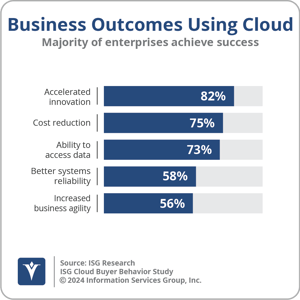The migration of on-premises applications to the cloud has become more than just a technological shift; it’s a strategic imperative for enterprises. This transition, driven by the need for competitiveness, agility and responsiveness in a rapidly evolving business environment that operates at the speed of digital, is not a simple task. It requires a careful balance between the technology roadmap and the strategic business objectives of the organization.
Enterprise IT leaders are tasked with the challenge of aligning their cloud migration strategy with the broader business goals. These include improving operational efficiency, driving innovation, enhancing customer experiences and more. The focus is not just on adopting cloud technology, but on leveraging it to achieve strategic business outcomes.
The conversation should shift from viewing cloud migration as primarily a strategic imperative to its role in identifying and achieving strategic business outcomes. This shift in perspective can help enterprises maximize the value of their cloud investments and drive meaningful business transformation. It’s about making the cloud work for your business, not just moving your business to the cloud. This is the true power of cloud technology. It’s not just about where your applications reside, but how they can help you achieve your business objectives.
These outcomes, achieved through the flexibility, scalability and robustness of cloud technology, are transforming business operations and competition in today’s digital landscape. Our software research reinforces these points. In the most recent ISG Cloud Survey, enterprise CIOs and IT leaders were asked to evaluate a variety of business outcomes against their use of cloud computing, specifically, "How successful has your organization been at achieving these business outcomes in using cloud?"
Five business outcomes stood out, each receiving a mean response score of 56% to 82%. They include Accelerated Innovation, Cost Reduction, Ability to Access Data, Better Systems Reliability, and Increased Business Agility. Why are enterprises finding success in achieving business outcomes due to cloud programs?
Reliability, and Increased Business Agility. Why are enterprises finding success in achieving business outcomes due to cloud programs?
Accelerated Innovation: Cloud technology catalyzes innovation in enterprises. The flexibility and scalability offered by cloud computing enables businesses to experiment with new ideas without significant upfront investment. This leads to faster product development cycles, improved customer experiences and the ability to quickly adapt to market changes. This also fosters collaboration, allowing teams to work together seamlessly, irrespective of their geographical locations.
Cost Reduction: Another significant benefit of cloud adoption is cost reduction. The shift from capital expenditure to operational expenditure models, the ability to pay for only the resources used and the reduction in costs associated with maintaining physical infrastructure all contribute to significant cost savings. Moreover, the cloud’s scalability allows businesses to easily adjust their resource usage based on demand, preventing overprovisioning and underutilization.
Ability to Access Data: The cloud greatly improves data accessibility. Businesses can now access their data from anywhere, at any time and on any device. This not only increases efficiency but also enables real-time decision-making based on up-to-date information. Furthermore, cloud storage approaches provide robust security measures, ensuring that sensitive data is protected.
Better Systems Reliability: Another key outcome of enterprise cloud computing programs is improved systems reliability. Cloud providers offer high availability, disaster recovery and backup approaches, ensuring business continuity even in the face of unforeseen circumstances. The burden of system maintenance and updates is also handled by the cloud provider, allowing enterprises to focus on core operations.
Increased Business Agility: Cloud technology promotes business agility. The ability to quickly scale up or down based on business needs, combined with the speed of deploying new applications, gives businesses the agility to respond to market changes swiftly and effectively.
Reflect on these outcomes and consider your enterprise experiences. If given the opportunity to launch a cloud program again, would you set the same business objectives or take a different approach?
CIOs and IT leaders should apply these insights to drive their organization’s cloud strategy. Begin by assessing your current cloud programs against these five outcomes. Identify areas of success and areas that need improvement. Use this information to refine your cloud strategy and align it more closely with your business objectives.
Foster a culture of innovation within your organization. Encourage teams to experiment with new ideas and leverage the cloud’s capabilities to bring these ideas to life. This will not only accelerate innovation but also improve customer and partner experiences and responsiveness to market changes.
Continuously monitor and optimize your cloud usage. Regularly review your cloud costs, data accessibility, system health and business agility. Make necessary adjustments to ensure you’re maximizing the value of your cloud investments. Remember, the cloud is not a one-size-fits-all solution. It requires a tailored approach that aligns with your unique business needs and objectives.
Cloud computing offers immense potential to transform your enterprise. But realizing this potential requires a strategic approach, continuous optimization and a culture that embraces innovation.
Regards,
Jeff Orr

 Reliability, and Increased Business Agility. Why are enterprises finding success in achieving business outcomes due to cloud programs?
Reliability, and Increased Business Agility. Why are enterprises finding success in achieving business outcomes due to cloud programs?








